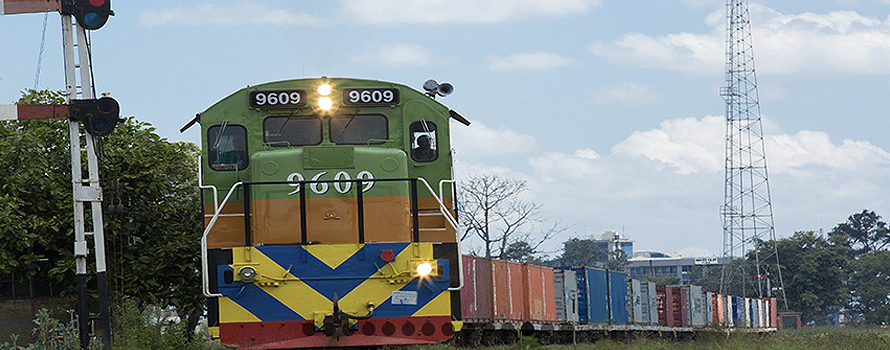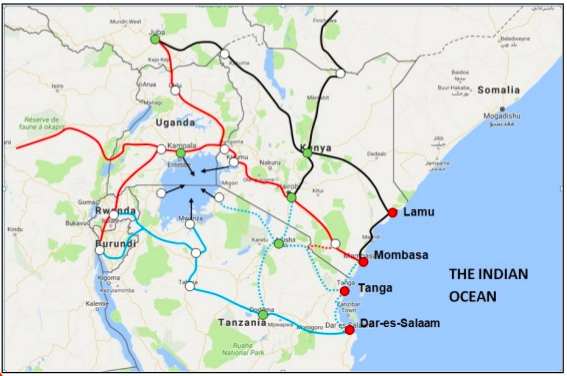Kenya has first section of new railway network financed with financial aid from Beijing
Africa's participation in the New Silk Road promoted by China involves connecting the hinterland of several East African countries with the main ports on its Indian coast. The designed railway network , which introduces standard gauge in the region, has started to operate between Kenya's two main cities: Nairobi and the port of Mombasa. But the full realization of the project is subject to the questionable Chinese investment model .

▲Freight transport between Nairobi and Mombasa [Kenya Railways].
April 27, 2018
article / Claudia Correa and Alexia Cosmello
Sino-African relations date back to the 15th century when Zhang, the navigator and trader, arrived on the shores of Mozambique. However, it was with Mao Zedong in 1949 that real relations were established. With promises of respect and taking into account the wounds left by colonization, China has economically assisted Africa to become its main economic partner since 2009. Through the implementation of economic and technological cooperation projects, it has financed the construction of hydroelectric power plants, dams, airports, aqueducts, hospitals, refineries, gas pipelines, railways and highways in 52 of the 54 African countries.
Cooperation between China and Africa has grown considerably. Since 2000, ministerial conferences of the Forum for China-Africa Cooperation (FOCAC) have been held, increasing trade and partnership in areas such as Education, science, technology and health. On the other hand, with regard to loans and investments, China has announced that it will allocate a large part of its capital to projects on the African continent. In 2013, for example, Chinese President Xi Jinping pledged 14.4 billion euros for infrastructure built by Chinese companies, while in 2014, Premier Li Keqiang announced that China would allocate a further 8.6 billion euros to development projects in Africa.
China's rise and intention to broaden and deepen its influence in the world has been very clear in recent years. In September 2013, Xi Jinping presented a new public works expansion project called the New Silk Road. With the goal of positioning itself in world trade, China aims to improve Asia's connections with other regions through the construction of land routes and the articulation of a maritime route to facilitate trade. Although it is an initiative that will be useful for the international community, it is necessary to emphasize the benefits it will represent for Africa, since the East African transport network will be built in its territory, so that this part of the African continent will have greater access to world trade, as well as new infrastructure with state-of-the-art technology.
Standard Gauge Railway
The East African freight and passenger network goal to connect the most important cities in Kenya with Kampala, the capital of Uganda; Bujumbura, the capital of Burundi; Juba, the capital of South Sudan; and Kigali, the capital of Rwanda. It is planned to apply standard gauge to most of the route, so the project is known as Standard Gauge Railway (SGR). It is estimated that the railway network will measure around 2,935 kilometers in total and will cost around $13.8 billion. Most of the financing will be provided position the Chinese government, together with financial aid from EiximBank, which will finance 90% of the construction costs, while the Kenyan government will finance only the remaining 10%. The work will be carried out by the Chinese business Road & Bridge Corporation, which is considered the public business with the largest presence and entrepreneurship in Africa.
The first phase of the project, called Madaraka Express, has been completed and was inaugurated in May 2017. The initiative involved the construction of a railway line to link Nairobi, the capital of Kenya, with Mombasa, the most important port city in Kenya and East Africa. The train can carry 1,260 passengers over a stretch of approximately 470 km. Having already built one of the key parts of the transport network , it is possible to continue with the project and move on to the second phase, which will consist of extending the railway lines to the rest of the cities mentioned above.
|

project of the new railway network [Kenya Railways].
|
China's investment in the world's largest
What are China's purposes for investing in Africa? It probably does so because it is a large potential market for the sale of its products, as well as a large source natural resources. In East Africa, for example, there is the oil from Kenya or essential materials for cell phone batteries in Malawi. In any case, it is clear that this is not a charitable act on the part of the Chinese, as it has been shown that Chinese banks and companies offer financing because it allows them to secure a larger market share in Africa as part of their strategy to go global.
According to Li Keqiang, Chinese Premier, "cooperation with Africa is based on respect, equality and mutual benefit". African representatives are enthusiastic about China's investment in African development . The Kenyan president declared that the new train "will revolutionize the Economics of the region and reaffirm Kenya's status as an economic hub", and Malawi's ambassador, Wang Shiting, expressed his thoughts on African development , stating that Africa will only improve when everyone contributes to its development, which is precisely what China is currently doing.
agreement to these official opinions, from the African point of view, China's intervention in the continent is not seen as something negative. However, it does present certain problems, such as the suspicion and accusation of corruption on the part of Chinese investors or the complaint that it is aggravatingly widening the economic gap between the more and less well-off, as Chinese investors logically expect to do business with the continent's elites. There is also the mistreatment of the environment, such as the controversy over the environmental impact of the aforementioned railway network , especially in Kenya, where the population has questioned the route through Nairobi Park because of the environmental impact.
It is not only Chinese companies that are investing in the African continent; some Western and European companies have, in some cases, replaced Chinese companies. A great example is the U.S. multinational General Electric, which in just one year has tripled its workforce in Nigeria, Kenya and Ethiopia. This is possible as a result of the delays or paralysis that some projects have suffered due to the sudden drop in raw material prices and the Chinese slowdown. Thanks to this, some African countries with sufficient financial structure have taken the initiative themselves to prevent projects from being buried.